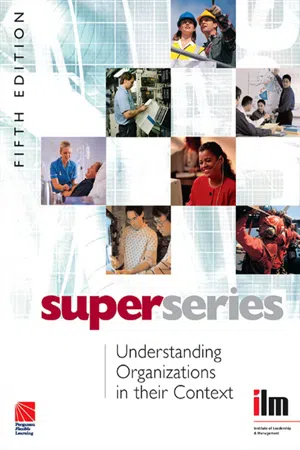
This is a test
- 232 pages
- English
- ePUB (mobile friendly)
- Available on iOS & Android
eBook - ePub
Understanding Organisations in their Context
Book details
Book preview
Table of contents
Citations
About This Book
Super series are a set of workbooks to accompany the flexible learning programme specifically designed and developed by the Institute of Leadership & Management (ILM) to support their Level 3 Certificate in First Line Management. The learning content is also closely aligned to the Level 3 S/NVQ in Management. The series consists of 35 workbooks. Each book will map on to a course unit (35 books/units).
Frequently asked questions
At the moment all of our mobile-responsive ePub books are available to download via the app. Most of our PDFs are also available to download and we're working on making the final remaining ones downloadable now. Learn more here.
Both plans give you full access to the library and all of Perlego’s features. The only differences are the price and subscription period: With the annual plan you’ll save around 30% compared to 12 months on the monthly plan.
We are an online textbook subscription service, where you can get access to an entire online library for less than the price of a single book per month. With over 1 million books across 1000+ topics, we’ve got you covered! Learn more here.
Look out for the read-aloud symbol on your next book to see if you can listen to it. The read-aloud tool reads text aloud for you, highlighting the text as it is being read. You can pause it, speed it up and slow it down. Learn more here.
Yes, you can access Understanding Organisations in their Context by Institute of Leadership in PDF and/or ePUB format, as well as other popular books in Commerce & Commerce Général. We have over one million books available in our catalogue for you to explore.
Information
Session E
The economic
environment
 | 1 | Introduction |
The effects of the economic policies of governments and, increasingly, of multinational corporations may seem remote from everyday life. But:


 | the decision of a multinational concern to relocate production facilities from, say, Scotland to China in pursuit – perhaps – of cheaper labour and lower safety, health and welfare standards will have direct local impact on employment and morale in the community. Whereas it was once common for employees to spend the whole of their working lives with one local employer, generation succeeding generation, this pattern is now very much the exception, even in formerly safe employment in banks, insurance companies, public utilities (electricity, gas, water, telecommunications) and railways. If you look at the jobs which members of your own family have done since the end of World War Two (1939–1945), the changing pattern will almost certainly become apparent. Some factors which directly affect people's everyday working lives are beyond the direct control of man. Examples include climate and weather, and natural disasters such as flooding, earthquakes and plagues (whether of locusts or the bubonic plague which killed millions of Europeans in the Middle Ages). |
In the early twentieth century much of the stock of grapevines in France was wiped out by the phyloxera virus. Wine making, of colossal economic importance and significance to national morale, was affected disastrously. It was eventually rescued by the importation of resistant strains from California – where they had been taken by economic migrants in the previous century.
Economic policies carried to either extreme of the political spectrum can produce profound and often disastrous consequences for organizations and the individuals who work for them.
The UK has never swung to either end of the political spectrum, but the protectionist Corn Laws of the 1830s and 1840s were a contributory factor to famine in Ireland. The result was a mass migration of people to America, and the memory of the famine still influences political attitudes in the twenty-first century, well over 150 years later.
All these issues raise moral, ethical, financial and economic questions to which there are seldom clear cut answers. The following activity illustrates the complexities involved.
Activity 56 |  |
You have come across a headline in the press that says carpets sold through a major chain of stores in the UK are being produced by child labour (from the age of six upwards) in sweatshops in central Asia. Child workers are preferred to adults because their small hands are claimed to be ideal for tying the tiny knots which give the carpets their undoubted quality. The children are paid a pittance by UK standards. The newspaper reports that there are fears about the long-term effects on the children's eyesight, and there is a risk of their developing arthritis in their fingers.
It would be quite practical for the carpets to be produced by means of power looms in the UK or Belgium. This would provide more employment in those countries, reduce the price to buyers and possibly generate more sales for the retailer. The machine-made carpets would still be of high quality, but would not match the hand-made originals.
However, there would be no chance of alternative employment for the children in Asia and there is no state schooling available to them.
1 | Think about this scenario for a while and then suggest suggest at least three r... |
Table of contents
- Front Cover
- Title Page
- Copyright
- Contents
- Series preface
- Unit specification
- Workbook introduction
- Session A Why organizations need to exist
- Session B The need for accounts
- Session C Financial information
- Session D Sources of finance
- Session E The economic environment
- Session F The global village
- Performance checks
- Reflect and review